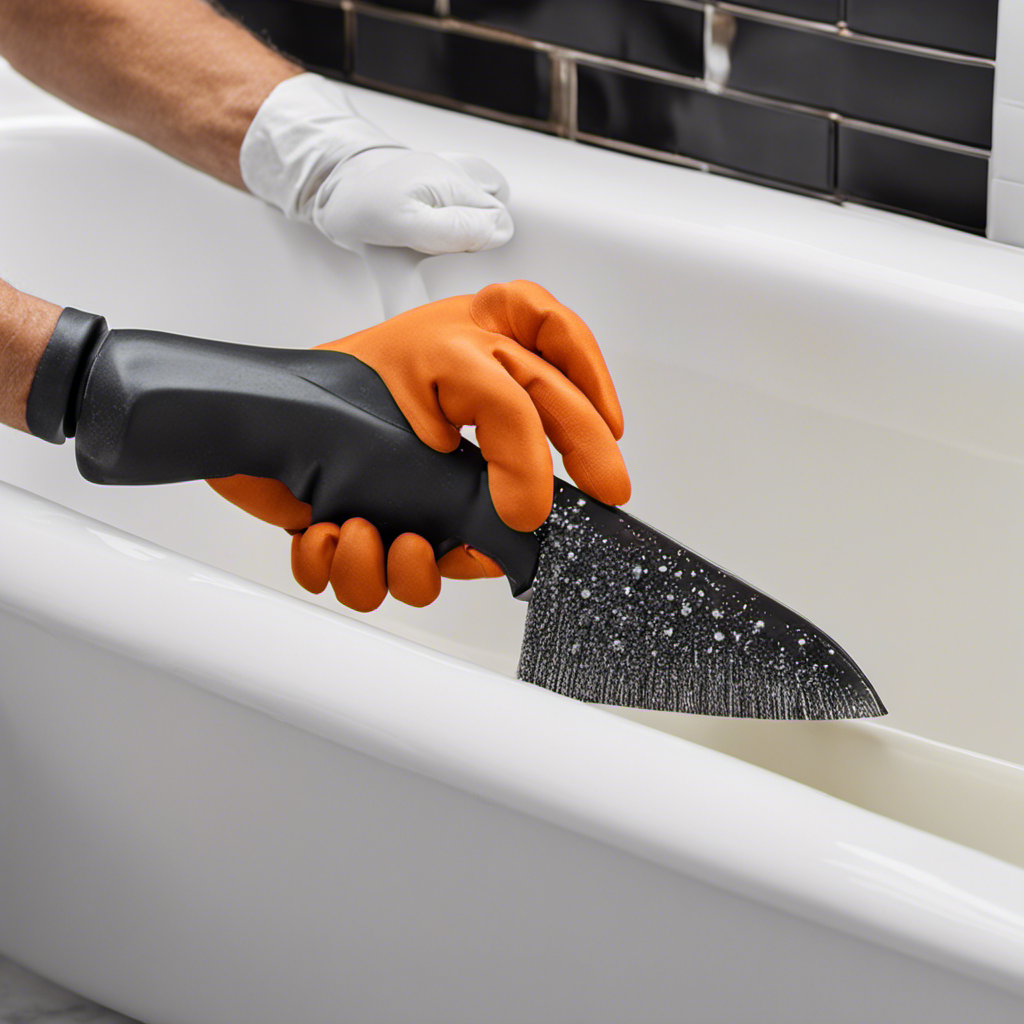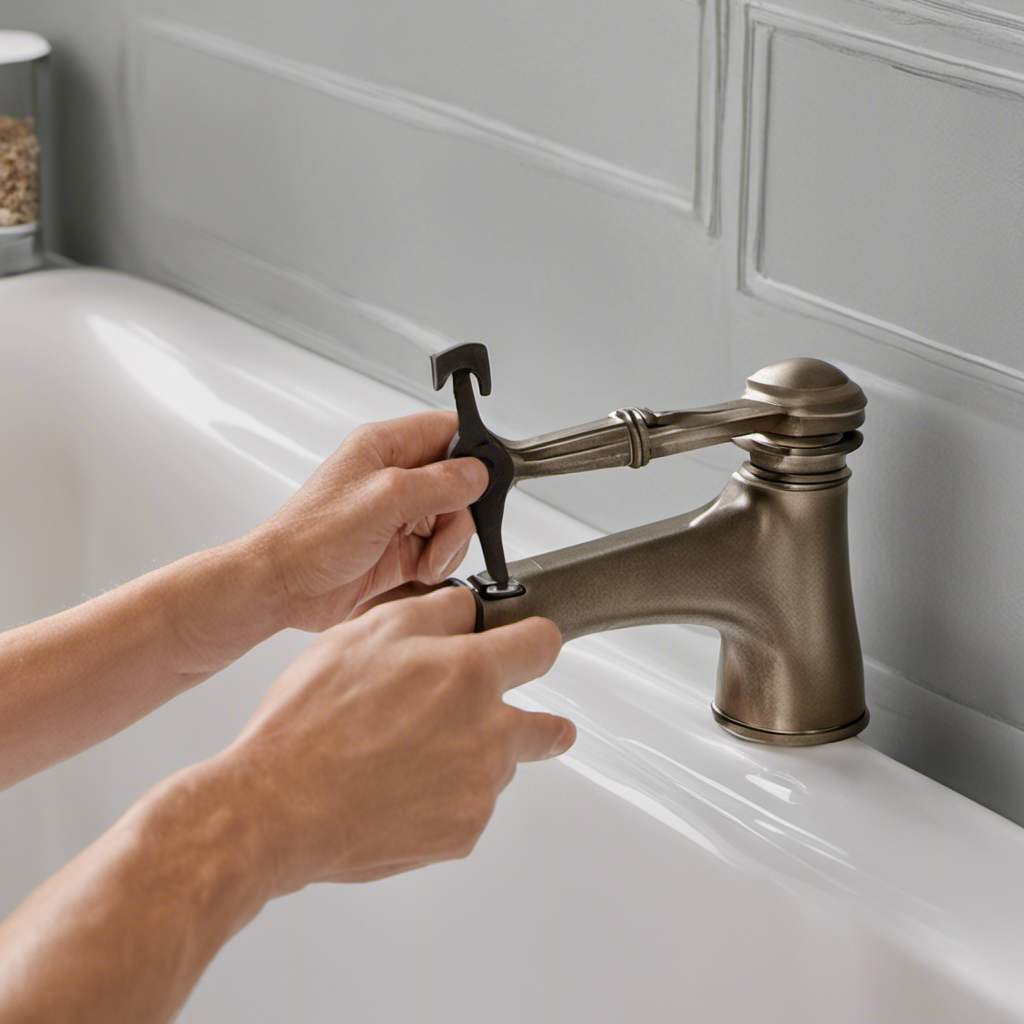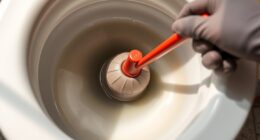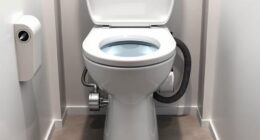Hey there! Ever found yourself in a sticky situation with adhesive in your bathtub? Well, fear not, because I’m here to help.
As a plumbing specialist, I’ve encountered my fair share of stubborn adhesives, and I’ve got the know-how to remove them effectively. In this article, I’ll guide you through step-by-step instructions on how to tackle different types of adhesives and various bathtub materials.
From chemical-based methods to natural remedies, I’ll provide you with multiple options to ensure a successful adhesive removal.
Let’s get started!
Key Takeaways
- Silicone caulking and epoxy adhesive are common types of adhesive used in bathtubs.
- To remove silicone adhesive, use a utility knife or scraper to cut or scrape it away, and then apply a caulk remover or solvent like mineral spirits to dissolve any remaining residue.
- To remove epoxy adhesive, use a heat gun or hairdryer to soften it, and then carefully lift and remove the epoxy with a putty knife or scraper.
- Chemical-based methods for removing adhesive include using adhesive remover (e.g., Goo Gone or WD-40), applying the remover to the adhesive, letting it sit to penetrate, gently scraping off the adhesive using a plastic scraper, and wiping away any remaining residue with a soft cloth.
Common Types of Adhesive Used in Bathtubs
One of the most common types of adhesive you’ll find in bathtubs is silicone caulking. Removing silicone adhesive from a bathtub requires specific steps and tools.
First, you’ll need a utility knife or a scraper to gently cut or scrape the caulk away from the surface. Then, use a caulk remover or a solvent like mineral spirits to dissolve any remaining residue. It’s important to follow the manufacturer’s instructions for the specific product you’re using.
Another type of adhesive commonly found in bathtubs is epoxy adhesive. To remove epoxy adhesive, you’ll need a heat gun or a hairdryer to soften the adhesive. Once it becomes pliable, use a putty knife or a scraper to carefully lift and remove the epoxy. Remember to work slowly and cautiously to avoid any damage to the bathtub surface.
Preparing the Bathtub for Adhesive Removal
To get started, make sure your bathtub is properly prepped for adhesive removal.
First, gather the necessary tools for effective adhesive removal. You’ll need a plastic scraper or putty knife to gently scrape off the adhesive without scratching the surface of the bathtub.
Additionally, have a bottle of adhesive remover or a mixture of warm water and dish soap ready.
Begin by applying the adhesive remover or soapy water to the stubborn adhesive. Allow it to sit for a few minutes to loosen the adhesive.
Then, use the plastic scraper or putty knife to carefully scrape away the softened adhesive. Be patient and repeat the process if necessary.
If you encounter any difficulties, try using a heat gun or a hairdryer to heat the adhesive before scraping.
Remember to always follow safety precautions and test any chemicals or heat sources on a small, inconspicuous area of the bathtub before applying them to the entire surface.
Chemical-Based Methods for Removing Adhesive
Using a chemical-based method to remove adhesive can be an effective solution for stubborn residue on your bathtub. As a plumbing specialist, I understand the importance of providing detailed instructions to ensure a successful outcome.
Here is a step-by-step guide on how to remove adhesive from your bathtub using chemical-based methods:
-
Start by gathering the necessary tools: a plastic scraper, adhesive remover (such as Goo Gone or WD-40), a soft cloth, and gloves.
-
Apply the adhesive remover directly to the adhesive residue, making sure to cover it completely.
-
Allow the remover to sit for a few minutes to penetrate the adhesive.
-
Use the plastic scraper to gently scrape off the adhesive, working in small sections.
-
Wipe away any remaining residue with a soft cloth.
Remember to follow the instructions provided by the adhesive remover manufacturer and wear gloves to protect your hands. If you prefer chemical-free methods or encounter difficulties, professional services for adhesive removal are also available.
Natural Remedies for Removing Adhesive
If you’re looking for a chemical-free alternative, natural remedies can effectively eliminate stubborn adhesive residue.
As a bathroom maintenance expert, I have encountered various scenarios where adhesive removal is necessary, and I’m here to provide you with eco-friendly solutions.
One home remedy involves using baking soda and coconut oil. Simply mix these two ingredients to create a paste and apply it to the adhesive. Let it sit for about 10 minutes, then scrub gently with a sponge or cloth.
Another option is vinegar. Soak a cloth in white vinegar and place it over the adhesive for 15 minutes. The acidity of the vinegar helps break down the adhesive, making it easier to remove.
For tougher adhesives, you can try using a hairdryer to heat the adhesive, then scrape it off with a plastic scraper.
These natural remedies are safe for both your health and the environment, providing an effective solution for adhesive removal in your bathtub.
Preventing Future Adhesive Build-Up in the Bathtub
One effective way to prevent future adhesive build-up in the bathtub is by regularly cleaning and drying the surface after each use. This simple maintenance routine will help avoid long term damage and save you from the hassle of removing stubborn adhesives later on.
Here are a few tips to keep your bathtub adhesive-free:
- Use a non-abrasive cleaner specifically designed for your bathtub material.
- Gently scrub the surface with a soft sponge or cloth to remove any residue.
- Rinse the bathtub thoroughly with warm water to ensure all cleaning agents are removed.
- Dry the bathtub completely using a clean, dry towel to prevent moisture from promoting adhesive build-up.
Conclusion
In conclusion, removing adhesive from a bathtub can be a challenging task, but with the right knowledge and tools, it can be done effectively.
By understanding the different types of adhesives used in bathtubs and preparing the bathtub properly, you can ensure a smooth removal process.
Chemical-based methods and natural remedies offer different options depending on your preferences.
It is also important to take preventive measures to avoid future adhesive build-up.
By following these step-by-step instructions and troubleshooting tips, you can successfully remove adhesive from your bathtub and maintain its cleanliness.










